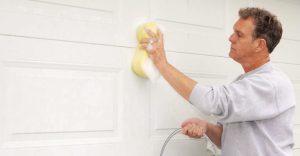 Your garage door is an essential part of your home that gets used nearly every day. Whether your garage contains vehicles, stored away Christmas decorations, or old photo albums stacked in boxes, the garage door keeps these items safe and secure. Regular maintenance can help you avoid mishaps, such as your garage door getting stuck or broken, and can ensure that your door is working up to your standards. These steps can make the job quick and painless and will prepare you for all your future garage door maintenance tasks.
Your garage door is an essential part of your home that gets used nearly every day. Whether your garage contains vehicles, stored away Christmas decorations, or old photo albums stacked in boxes, the garage door keeps these items safe and secure. Regular maintenance can help you avoid mishaps, such as your garage door getting stuck or broken, and can ensure that your door is working up to your standards. These steps can make the job quick and painless and will prepare you for all your future garage door maintenance tasks.
Inspection
 Your first task before making any repairs or modifications to your door should be inspecting all the hardware and performing safety tests. For optimal maintenance, these inspections should be done twice a year to ensure that everything is working properly. A well-maintained door will operate quietly and smoothly, so look for any unusual noises or jerky motions while the door is opening and closing. Be sure to inspect the door hinges and the tracks to see if anything needs to be tightened or replaced and to clear the tracks of any debris or rust. If you see anything out of the ordinary during your inspection, make a note of it so that you know to address it during your maintenance. Also, check the condition of the rubber weather stripping located along the bottom of the door. This weather stripping is meant to keep out any cold air, water, dust or other elements that the weather may bring, so make sure that it is in good shape. If it needs to be replaced, most weather stripping can easily slip in and out of a groove in the bottom of your door. You can buy replacement weather stripping at any local hardware store. Some garage doors may also have weather stripping on the sides of the door, so be sure to check the condition of these as well. Reattach any loose pieces if they’re salvageable, or replace the entire stripping if it is too worn or damaged. Weather stripping on the side of your door detaches differently than the bottom, so make sure you are replacing this properly based on your door. It’s important to inspect the cables and springs of your garage door as well, but it’s advised to not make any repairs or modifications to these on your own, as it can be dangerous. If you see any issues that need to be addressed in these areas, consult a professional for assistance.
Your first task before making any repairs or modifications to your door should be inspecting all the hardware and performing safety tests. For optimal maintenance, these inspections should be done twice a year to ensure that everything is working properly. A well-maintained door will operate quietly and smoothly, so look for any unusual noises or jerky motions while the door is opening and closing. Be sure to inspect the door hinges and the tracks to see if anything needs to be tightened or replaced and to clear the tracks of any debris or rust. If you see anything out of the ordinary during your inspection, make a note of it so that you know to address it during your maintenance. Also, check the condition of the rubber weather stripping located along the bottom of the door. This weather stripping is meant to keep out any cold air, water, dust or other elements that the weather may bring, so make sure that it is in good shape. If it needs to be replaced, most weather stripping can easily slip in and out of a groove in the bottom of your door. You can buy replacement weather stripping at any local hardware store. Some garage doors may also have weather stripping on the sides of the door, so be sure to check the condition of these as well. Reattach any loose pieces if they’re salvageable, or replace the entire stripping if it is too worn or damaged. Weather stripping on the side of your door detaches differently than the bottom, so make sure you are replacing this properly based on your door. It’s important to inspect the cables and springs of your garage door as well, but it’s advised to not make any repairs or modifications to these on your own, as it can be dangerous. If you see any issues that need to be addressed in these areas, consult a professional for assistance.
A few different safety tests can be performed to see if your garage door is operating properly. The first is to test the door balance. To do this, make sure that the door is operating manually (disconnect it from the opener) and pull it to about halfway up the tracks. If it stays in place without assistance, it’s properly balanced. If it begins to move, it is improperly balanced. Consult a professional to fix this issue, as it is most likely a problem with the springs. Another test that you can perform is to test the auto-reverse feature on your garage. Place an object—perhaps a brick or plank of wood—in the path of your door and activate the door to close. The reverse feature should cause the door to automatically reverse directions when it comes in contact with the object. If the door does not reverse, contact a professional to further inspect the problem. You should also check the alignment and function of the sensors used for the auto-reverse feature. To do this, line up your sensors to where they light up, indicating proper alignment. Activate your door to close and then place an object between the sensors. The garage door should automatically reverse, and if it doesn’t, contact a professional to further inspect your sensors.
Maintenance
 After your inspection, you can begin any maintenance that you deemed necessary while inspecting. If you’re doing a routine maintenance check-up, it would be beneficial to service most if not all of your garage door hardware. A good place to start would be checking the battery on your opener. To do this, unplug the opener and open the garage door with your wall button. If the door doesn’t open, it’s time to replace the battery in your opener. Remove the cover of your opener with a screwdriver, and replace the old battery with a new one. Go ahead and replace the batteries in the remote and keypad for your opener as well. If there are lights on your opener—or in your garage in general—check the light bulbs to see if they need to be replaced.
After your inspection, you can begin any maintenance that you deemed necessary while inspecting. If you’re doing a routine maintenance check-up, it would be beneficial to service most if not all of your garage door hardware. A good place to start would be checking the battery on your opener. To do this, unplug the opener and open the garage door with your wall button. If the door doesn’t open, it’s time to replace the battery in your opener. Remove the cover of your opener with a screwdriver, and replace the old battery with a new one. Go ahead and replace the batteries in the remote and keypad for your opener as well. If there are lights on your opener—or in your garage in general—check the light bulbs to see if they need to be replaced.
 If the chain or belt for your door is in need of service, this can easily be fixed on your own. To work on the chain or belt, disconnect the opener from power and raise the door to about halfway. Detach the door from the opener and close it manually. There should be an adjustment bolt on the mechanism that connects to the chain or belt accompanied by two nuts that adjust. Use a wrench to turn these bolts until the chain or belt picks up slack then tighten the chain or belt until it is about ¼ inch from the bottom of the rail. Be sure not to over tighten the chain or belt, as this can lead to a break. Reattach the door to the opener, and connect the opener back to power. Lubricate the chain or belt with a spray lubricant, such as white lithium grease, to ensure that it will move smoothly. If you complete this service and your chain or belt is still not functioning properly, contact a professional to see what else may be causing the problem.
If the chain or belt for your door is in need of service, this can easily be fixed on your own. To work on the chain or belt, disconnect the opener from power and raise the door to about halfway. Detach the door from the opener and close it manually. There should be an adjustment bolt on the mechanism that connects to the chain or belt accompanied by two nuts that adjust. Use a wrench to turn these bolts until the chain or belt picks up slack then tighten the chain or belt until it is about ¼ inch from the bottom of the rail. Be sure not to over tighten the chain or belt, as this can lead to a break. Reattach the door to the opener, and connect the opener back to power. Lubricate the chain or belt with a spray lubricant, such as white lithium grease, to ensure that it will move smoothly. If you complete this service and your chain or belt is still not functioning properly, contact a professional to see what else may be causing the problem.
 It’s important to lubricate all moving parts of your garage door during your routine maintenance. The rollers and hinges on your door are susceptible to breaking or getting stuck if not properly cared for, so be sure to lubricate the wheels on your door as well as any hinges that are being consistently used. Try to avoid directly lubricating the tracks, as this can cause your door to slip and become unbalanced. If you are having an issue where there is friction building up between the door and the track, adjusting the track bracket can solve this issue. To do this, loosen up the nuts that hold the bracket and the door close to one another and make sure that there is about a ½-inch gap between the door and the tracks. Go around and tighten up any loose nuts or bolts in your garage door and check that everything is looking and working the way that you want it to.
It’s important to lubricate all moving parts of your garage door during your routine maintenance. The rollers and hinges on your door are susceptible to breaking or getting stuck if not properly cared for, so be sure to lubricate the wheels on your door as well as any hinges that are being consistently used. Try to avoid directly lubricating the tracks, as this can cause your door to slip and become unbalanced. If you are having an issue where there is friction building up between the door and the track, adjusting the track bracket can solve this issue. To do this, loosen up the nuts that hold the bracket and the door close to one another and make sure that there is about a ½-inch gap between the door and the tracks. Go around and tighten up any loose nuts or bolts in your garage door and check that everything is looking and working the way that you want it to.
Cleaning
 The last part of your routine garage door maintenance should be cleaning up and maintaining the outside of your door. Common garage door materials, such as steel, can become rusted or weathered if not cared for regularly. Inspect your door before cleaning and look for any rust spots or problem areas that may need to be sanded down or painted over. If your door is wooden, it’s important to be more cautious about water damage and warping while cleaning, so avoid spraying it down with water. Instead, wipe it down with a clean and dry cloth. Look for any areas that may need sanding and repainting or staining, and take care of those as needed. Vinyl, fiberglass, or other synthetic material doors can be wiped down with a soft cloth and an all-purpose cleaner.
The last part of your routine garage door maintenance should be cleaning up and maintaining the outside of your door. Common garage door materials, such as steel, can become rusted or weathered if not cared for regularly. Inspect your door before cleaning and look for any rust spots or problem areas that may need to be sanded down or painted over. If your door is wooden, it’s important to be more cautious about water damage and warping while cleaning, so avoid spraying it down with water. Instead, wipe it down with a clean and dry cloth. Look for any areas that may need sanding and repainting or staining, and take care of those as needed. Vinyl, fiberglass, or other synthetic material doors can be wiped down with a soft cloth and an all-purpose cleaner.
Once you’re done wiping down your door with its respective cleaner, thoroughly rinse it (if it’s not wooden) with a hose and dry it off. You can clean the inside of the door using these same steps based on its material. If you think the inside is relatively clean and you’d like to skip this step, dusting off any dirt, dust or cobwebs should suffice for a quicker clean.
 Once all of your cleaning, repairs, replacements and modifications on your garage door are finished, it should be good to go for at least another six months. To maintain a healthy garage door, this type of maintenance should be done twice a year. You can easily add it to your other seasonal responsibilities, such as prepping your yard for spring and fall. Garage door maintenance is a task that is often overlooked, but it is a very important job, especially if you are using your garage door daily. Adding this into your cycle of home and yard maintenance can make a huge difference for you and your home.
Once all of your cleaning, repairs, replacements and modifications on your garage door are finished, it should be good to go for at least another six months. To maintain a healthy garage door, this type of maintenance should be done twice a year. You can easily add it to your other seasonal responsibilities, such as prepping your yard for spring and fall. Garage door maintenance is a task that is often overlooked, but it is a very important job, especially if you are using your garage door daily. Adding this into your cycle of home and yard maintenance can make a huge difference for you and your home. ![]()
Rylee Mehr
Home & Yard Magazine




